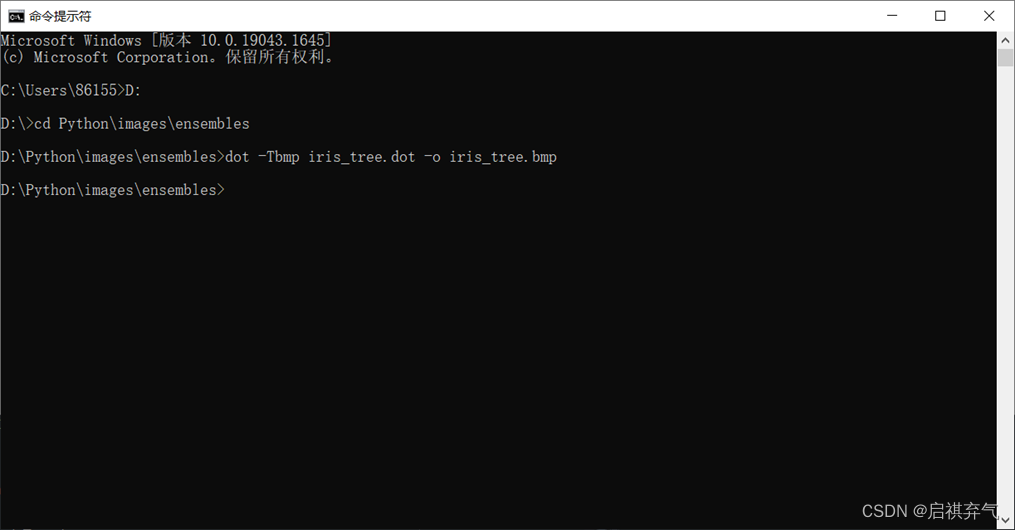
机器学习与模式识别实验_Anaconda3_Python
第四次实验:Iris 与集成学习目录第四次实验:Iris 与集成学习前言一、实验内容概述二、使用步骤1、检查python以及机器学习的版本是否达到要求,导入一些基础的包,并设置字体、创建图像保存的地址即函数;2、导入实验要求的iris数据集,按7:3 的比例随机划分为训练集和验证集,随机数生成器种子为学号后三位数(即211),并输出训练集和验证集前10行数据。3、在训练集上训练决策树模型,生成决策
第四次实验:Iris 与集成学习
目录
1、检查python以及机器学习的版本是否达到要求,导入一些基础的包,并设置字体、创建图像保存的地址即函数;
2、导入实验要求的iris数据集,按7:3 的比例随机划分为训练集和验证集,随机数生成器种子为学号后三位数(即211),并输出训练集和验证集前10行数据。
4、在训练集上训练Boosting(基学习器:决策树)和随机森林模型,基学习器个数为100,输出决策边界图,并分析结果差异;
5、分别计算决策树、Boosting(基学习器:决策树)和随机森林模型在Iris数据集上三分类的混淆矩阵,并对三种算法的输出结果进行比较。
4_ensemble_learning_and_random_forests.py
前言
新手上路,请多指正!
一、实验内容概述
1. 将数据集按7:3 的比例随机划分为训练集和验证集,并输出训练集和验证集前10行数据;
2. 在训练集上训练决策树模型,生成决策树边界
3. 在训练集上训练Boosting(基学习器:决策树)和随机森林模型,基学习器个数为100,输出决策边界图,并分析结果差异;
4. 分别计算决策树、Boosting(基学习器:决策树)和随机森林模型在Iris数据集上三分类的混淆矩阵,并对三种算法的输出结果进行比较.
二、使用步骤
1、检查python以及机器学习的版本是否达到要求,导入一些基础的包,并设置字体、创建图像保存的地址即函数;
1. # -*- coding: utf-8 -*-
2. # Python ≥3.5 is required
3. import sys
4. assert sys.version_info >= (3, 5)
5.
6. # Scikit-Learn ≥0.20 is required
7. import sklearn
8. assert sklearn.__version__ >= "0.20"
9.
10. # Common imports
11. import numpy as np
12. import os
13.
14. # to make this notebook's output stable across runs
15. np.random.seed(211)
16.
17. # To plot pretty figures
18. import matplotlib as mpl
19. import matplotlib.pyplot as plt
20. plt.rcParams['font.sans-serif'] = ['Microsoft YaHei']
21.
22. # Where to save the figures
23. PROJECT_ROOT_DIR = "."
24. CHAPTER_ID = "ensembles"
25. IMAGES_PATH = os.path.join(PROJECT_ROOT_DIR, "images", CHAPTER_ID)
26. os.makedirs(IMAGES_PATH, exist_ok=True)
27.
28.
29. def save_fig(fig_id, tight_layout=True, fig_extension="png", resolution=300):
30. path = os.path.join(IMAGES_PATH, fig_id + "." + fig_extension)
31. print("Saving figure", fig_id)
32. if tight_layout:
33. plt.tight_layout()
34. plt.savefig(path, format=fig_extension, dpi=resolution)
2、导入实验要求的iris数据集,按7:3 的比例随机划分为训练集和验证集,随机数生成器种子为学号后三位数(即211),并输出训练集和验证集前10行数据。
1. from sklearn.datasets import load_iris
2. from sklearn.model_selection import train_test_split
3.
4. iris = load_iris()
5. X = iris.data
6. y = iris.target
7. X_train, X_test, y_train, y_test = train_test_split(X, y, test_size=0.3,
8. random_state=211)
9. print("训练集前十个数据:\n",np.c_[X_train[:10],y_train[:10]])
10. print("测试集前十个数据:\n",np.c_[X_test[:10],y_test[:10]])
3、在训练集上训练决策树模型,生成决策树边界;
1. from sklearn.tree import DecisionTreeClassifier #决策树的分类器
2. from graphviz import Source
3. from sklearn.tree import export_graphviz
4.
5. tree_clf = DecisionTreeClassifier(max_depth=4, random_state=211) #决策树初始化
6. tree_clf.fit(X_train, y_train)
7. score = tree_clf.score(X_test, y_test) # 训练集计算得分
8.
9. export_graphviz(
10. tree_clf,
11. out_file=os.path.join(IMAGES_PATH, "iris_tree.dot"),
12. feature_names=iris.feature_names,
13. class_names=iris.target_names,
14. rounded=True,
15. filled=True
16. )
17.
18. Source.from_file(os.path.join(IMAGES_PATH, "iris_tree.dot"))
19. # 此处使用cmd将dot转换成pdf
20.
21. from matplotlib.colors import ListedColormap
22.
23.
24. def plot_decision_boundary(clf, X, y, axes=[0, 8, 0, 3], alpha=0.8, contour=True):
25. x1s = np.linspace(axes[0], axes[1], 100)
26. x2s = np.linspace(axes[2], axes[3], 100)
27. x1, x2 = np.meshgrid(x1s, x2s)
28. X_new = np.c_[x1.ravel(), x2.ravel(), x1.ravel(), x2.ravel()]
29. y_pred = clf.predict(X_new).reshape(x1.shape)
30. custom_cmap = ListedColormap(['#fafab0', '#9898ff', '#a0faa0'])
31. plt.contourf(x1, x2, y_pred, alpha=0.3, cmap=custom_cmap)
32. if contour:
33. custom_cmap2 = ListedColormap(['#7d7d58', '#4c4c7f', '#507d50'])
34. plt.contour(x1, x2, y_pred, cmap=custom_cmap2, alpha=0.8)
35. plt.plot(X[:, 2][y==0], X[:, 3][y==0], "yo", alpha=alpha, label="Iris setosa")
36. plt.plot(X[:, 2][y==1], X[:, 3][y==1], "bs", alpha=alpha, label="Iris versicolor")
37. plt.plot(X[:, 2][y==2], X[:, 3][y==2], "r^", alpha=alpha, label="Iris virginica")
38. plt.axis(axes)
39. plt.xlabel(r"$x_1$", fontsize=18)
40. plt.ylabel(r"$x_2$", fontsize=18, rotation=0)
41.
42.
43. plot_decision_boundary(tree_clf, X_train, y_train)
44. plt.xlabel("petal length/cm", fontsize=14)
45. plt.ylabel("petal width/cm", rotation='vertical', fontsize=14)
46. plt.title("decision tree decision boundaries plot", fontsize=16)
47. plt.text(1.40, 1.0, "Depth=0", fontsize=15)
48. plt.text(3.2, 1.80, "Depth=1", fontsize=13)
49. plt.text(4.05, 0.5, "Depth=2", fontsize=11)
50.
51. save_fig("decision_tree_decision_boundaries_plot")
52. plt.show()

4、在训练集上训练Boosting(基学习器:决策树)和随机森林模型,基学习器个数为100,输出决策边界图,并分析结果差异;
1. from sklearn.ensemble import AdaBoostClassifier
2. ada_clf = AdaBoostClassifier(
3. DecisionTreeClassifier(max_depth=4), n_estimators=100,
4. algorithm="SAMME.R", learning_rate=0.5, random_state=211)
5. ada_clf.fit(X_train, y_train)
6.
7.
8. def plot_decision_boundary(clf, X, y, axes=[0, 8, 0, 2.8], alpha=0.8, contour=True):
9. x1s = np.linspace(axes[0], axes[1], 100)
10. x2s = np.linspace(axes[2], axes[3], 100)
11. x1, x2 = np.meshgrid(x1s, x2s)
12. X_new = np.c_[x1.ravel(), x2.ravel(), x1.ravel(), x2.ravel()]
13. y_pred = clf.predict(X_new).reshape(x1.shape)
14. custom_cmap = ListedColormap(['#fafab0', '#9898ff', '#a0faa0'])
15. plt.contourf(x1, x2, y_pred, alpha=0.3, cmap=custom_cmap)
16. if contour:
17. custom_cmap2 = ListedColormap(['#7d7d58', '#4c4c7f', '#507d50'])
18. plt.contour(x1, x2, y_pred, cmap=custom_cmap2, alpha=0.8)
19. plt.plot(X[:, 2][y==0], X[:, 3][y==0], "yo", alpha=alpha, label="Iris setosa")
20. plt.plot(X[:, 2][y==1], X[:, 3][y==1], "bs", alpha=alpha, label="Iris versicolor")
21. plt.plot(X[:, 2][y==2], X[:, 3][y==2], "r^", alpha=alpha, label="Iris virginica")
22. plt.axis(axes)
23. plt.xlabel(r"$x_1$", fontsize=18)
24. plt.ylabel(r"$x_2$", fontsize=18, rotation=0)
25.
26.
27. # 随机森林
28. from sklearn.ensemble import RandomForestClassifier
29. rnd_clf = RandomForestClassifier(n_estimators=100, random_state=211)
30. rnd_clf.fit(X_train, y_train)
31.
32. # 决策边界图绘制
33. fig, axes = plt.subplots(ncols=2, figsize=(10, 2.7), sharey=True)
34. plt.sca(axes[0])
35. plot_decision_boundary(ada_clf, X, y)
36. plt.xlabel("petal length/cm", fontsize=14)
37. plt.ylabel("petal width/cm", rotation='vertical', fontsize=14)
38. plt.title("boost决策边界 learning_rate=0.5 n_estimators=100",
39. fontsize=14)
40.
41. plt.sca(axes[1])
42. plot_decision_boundary(rnd_clf, X, y)
43. plt.xlabel("petal length/cm", fontsize=14)
44. plt.ylabel("petal width/cm", rotation='vertical', fontsize=14)
45. plt.title("随机森林决策边界 n_estimators=100", fontsize=14)
46. plt.suptitle("我是five", fontsize=16)
47.
48. save_fig("Random_forest_decision_boundary_plot")
49. plt.show()
5、分别计算决策树、Boosting(基学习器:决策树)和随机森林模型在Iris数据集上三分类的混淆矩阵,并对三种算法的输出结果进行比较。
1. # 混淆矩阵
2. from sklearn.metrics import confusion_matrix
3. y_pre1 = tree_clf.predict(X_test)
4. y_pre2 = ada_clf.predict(X_test)
5. y_pre3 = rnd_clf.predict(X_test)
6. confusion1 = confusion_matrix(y_test, y_pre1)
7. confusion2 = confusion_matrix(y_test, y_pre2)
8. confusion3 = confusion_matrix(y_test, y_pre3)
9. print("决策树混淆矩阵 :\n",confusion1)
10. print("Boosting混淆矩阵 :\n", confusion2)
11. print("随机森林混淆矩阵 :\n", confusion3)
后记
随着学习的不断深入,我逐渐感觉我是five!而且我也辜负了我的会长小小鑫121,不好意思对面道歉,只好在这里道个歉,对不起!
附:源代码
4_ensemble_learning_and_random_forests.py
1. # -*- coding: utf-8 -*-
2. # Python ≥3.5 is required
3. import sys
4. assert sys.version_info >= (3, 5)
5.
6. # Scikit-Learn ≥0.20 is required
7. import sklearn
8. assert sklearn.__version__ >= "0.20"
9.
10. # Common imports
11. import numpy as np
12. import os
13.
14. # to make this notebook's output stable across runs
15. np.random.seed(211)
16.
17. # To plot pretty figures
18. import matplotlib as mpl
19. import matplotlib.pyplot as plt
20. plt.rcParams['font.sans-serif'] = ['Microsoft YaHei']
21.
22. # Where to save the figures
23. PROJECT_ROOT_DIR = "."
24. CHAPTER_ID = "ensembles"
25. IMAGES_PATH = os.path.join(PROJECT_ROOT_DIR, "images", CHAPTER_ID)
26. os.makedirs(IMAGES_PATH, exist_ok=True)
27.
28.
29. def save_fig(fig_id, tight_layout=True, fig_extension="png", resolution=300):
30. path = os.path.join(IMAGES_PATH, fig_id + "." + fig_extension)
31. print("Saving figure", fig_id)
32. if tight_layout:
33. plt.tight_layout()
34. plt.savefig(path, format=fig_extension, dpi=resolution)
35.
36.
37. from sklearn.datasets import load_iris
38. from sklearn.model_selection import train_test_split
39.
40. iris = load_iris()
41. X = iris.data
42. y = iris.target
43. X_train, X_test, y_train, y_test = train_test_split(X, y, test_size=0.3,
44. random_state=211)
45. print("训练集前十个数据:\n",np.c_[X_train[:10],y_train[:10]])
46. print("测试集前十个数据:\n",np.c_[X_test[:10],y_test[:10]])
47.
48. from sklearn.tree import DecisionTreeClassifier #决策树的分类器
49. from graphviz import Source
50. from sklearn.tree import export_graphviz
51.
52. tree_clf = DecisionTreeClassifier(max_depth=4, random_state=211) #决策树初始化
53. tree_clf.fit(X_train, y_train)
54. score = tree_clf.score(X_test, y_test) # 训练集计算得分
55.
56. export_graphviz(
57. tree_clf,
58. out_file=os.path.join(IMAGES_PATH, "iris_tree.dot"),
59. feature_names=iris.feature_names,
60. class_names=iris.target_names,
61. rounded=True,
62. filled=True
63. )
64.
65. Source.from_file(os.path.join(IMAGES_PATH, "iris_tree.dot"))
66. # 此处使用cmd将dot转换成pdf
67.
68. from matplotlib.colors import ListedColormap
69.
70.
71. def plot_decision_boundary(clf, X, y, axes=[0, 8, 0, 3], alpha=0.8, contour=True):
72. x1s = np.linspace(axes[0], axes[1], 100)
73. x2s = np.linspace(axes[2], axes[3], 100)
74. x1, x2 = np.meshgrid(x1s, x2s)
75. X_new = np.c_[x1.ravel(), x2.ravel(), x1.ravel(), x2.ravel()]
76. y_pred = clf.predict(X_new).reshape(x1.shape)
77. custom_cmap = ListedColormap(['#fafab0', '#9898ff', '#a0faa0'])
78. plt.contourf(x1, x2, y_pred, alpha=0.3, cmap=custom_cmap)
79. if contour:
80. custom_cmap2 = ListedColormap(['#7d7d58', '#4c4c7f', '#507d50'])
81. plt.contour(x1, x2, y_pred, cmap=custom_cmap2, alpha=0.8)
82. plt.plot(X[:, 2][y==0], X[:, 3][y==0], "yo", alpha=alpha, label="Iris setosa")
83. plt.plot(X[:, 2][y==1], X[:, 3][y==1], "bs", alpha=alpha, label="Iris versicolor")
84. plt.plot(X[:, 2][y==2], X[:, 3][y==2], "r^", alpha=alpha, label="Iris virginica")
85. plt.axis(axes)
86. plt.xlabel(r"$x_1$", fontsize=18)
87. plt.ylabel(r"$x_2$", fontsize=18, rotation=0)
88.
89.
90. plot_decision_boundary(tree_clf, X_train, y_train)
91. plt.xlabel("petal length/cm", fontsize=14)
92. plt.ylabel("petal width/cm", rotation='vertical', fontsize=14)
93. plt.title("decision tree decision boundaries plot\n高啟祺 电信1904 0121909361211", fontsize=16)
94. plt.text(1.40, 1.0, "Depth=0", fontsize=15)
95. plt.text(3.2, 1.80, "Depth=1", fontsize=13)
96. plt.text(4.05, 0.5, "Depth=2", fontsize=11)
97.
98. save_fig("decision_tree_decision_boundaries_plot")
99. plt.show()
100.
101. from sklearn.ensemble import AdaBoostClassifier
102. ada_clf = AdaBoostClassifier(
103. DecisionTreeClassifier(max_depth=4), n_estimators=100,
104. algorithm="SAMME.R", learning_rate=0.5, random_state=211)
105. ada_clf.fit(X_train, y_train)
106.
107.
108. def plot_decision_boundary(clf, X, y, axes=[0, 8, 0, 2.8], alpha=0.8, contour=True):
109. x1s = np.linspace(axes[0], axes[1], 100)
110. x2s = np.linspace(axes[2], axes[3], 100)
111. x1, x2 = np.meshgrid(x1s, x2s)
112. X_new = np.c_[x1.ravel(), x2.ravel(), x1.ravel(), x2.ravel()]
113. y_pred = clf.predict(X_new).reshape(x1.shape)
114. custom_cmap = ListedColormap(['#fafab0', '#9898ff', '#a0faa0'])
115. plt.contourf(x1, x2, y_pred, alpha=0.3, cmap=custom_cmap)
116. if contour:
117. custom_cmap2 = ListedColormap(['#7d7d58', '#4c4c7f', '#507d50'])
118. plt.contour(x1, x2, y_pred, cmap=custom_cmap2, alpha=0.8)
119. plt.plot(X[:, 2][y==0], X[:, 3][y==0], "yo", alpha=alpha, label="Iris setosa")
120. plt.plot(X[:, 2][y==1], X[:, 3][y==1], "bs", alpha=alpha, label="Iris versicolor")
121. plt.plot(X[:, 2][y==2], X[:, 3][y==2], "r^", alpha=alpha, label="Iris virginica")
122. plt.axis(axes)
123. plt.xlabel(r"$x_1$", fontsize=18)
124. plt.ylabel(r"$x_2$", fontsize=18, rotation=0)
125.
126.
127. # 随机森林
128. from sklearn.ensemble import RandomForestClassifier
129. rnd_clf = RandomForestClassifier(n_estimators=100, random_state=211)
130. rnd_clf.fit(X_train, y_train)
131.
132. # 决策边界图绘制
133. fig, axes = plt.subplots(ncols=2, figsize=(10, 2.7), sharey=True)
134. plt.sca(axes[0])
135. plot_decision_boundary(ada_clf, X, y)
136. plt.xlabel("petal length/cm", fontsize=14)
137. plt.ylabel("petal width/cm", rotation='vertical', fontsize=14)
138. plt.title("boost决策边界 learning_rate=0.5 n_estimators=100",
139. fontsize=14)
140.
141. plt.sca(axes[1])
142. plot_decision_boundary(rnd_clf, X, y)
143. plt.xlabel("petal length/cm", fontsize=14)
144. plt.ylabel("petal width/cm", rotation='vertical', fontsize=14)
145. plt.title("随机森林决策边界 n_estimators=100", fontsize=14)
146. plt.suptitle("高啟祺 电信1904 0121909361211", fontsize=16)
147.
148. save_fig("Random_forest_decision_boundary_plot")
149. plt.show()
150.
151. # 混淆矩阵
152. from sklearn.metrics import confusion_matrix
153. y_pre1 = tree_clf.predict(X_test)
154. y_pre2 = ada_clf.predict(X_test)
155. y_pre3 = rnd_clf.predict(X_test)
156. confusion1 = confusion_matrix(y_test, y_pre1)
157. confusion2 = confusion_matrix(y_test, y_pre2)
158. confusion3 = confusion_matrix(y_test, y_pre3)
159. print("决策树混淆矩阵 :\n",confusion1)
160. print("Boosting混淆矩阵 :\n", confusion2)
161. print("随机森林混淆矩阵 :\n", confusion3)
更多推荐
 已为社区贡献2条内容
已为社区贡献2条内容








所有评论(0)